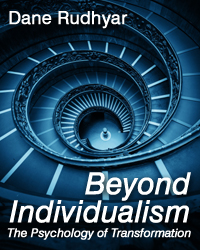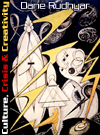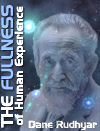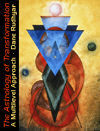Beyond Individualism
The Psychology of Transformation
by Dane Rudhyar
PART TWO:
THE SOCIAL-COLLECTIVE MODE
5. The Pattern of Differentitation & Conflict
According to the dialectical model of evolution outlined in the preceding chapters, a cycle of existence begins in a state of unity and witnesses a process of differentiation resulting in a multiplicity of existential forms and lines of development, all of which eventually converge. In the end these constitute a complex 'multi-une' whole in which what in the beginning was only a potentiality is finally found perfectly actualized.
So stated, however, the model fails to convey what we can assume to be a universal fact, if properly understood in its varied manifestations. This fact is that, at least in the universe we experience, all existence operates on a dualistic basis. Whenever a new kind of energy—a new source of useable power—is released and made available, its use can lead human beings to advance a step further toward the end-fulfillment of the purpose inherent in the entire existential cycle; but on the other hand, the misuse of that power—or the failure to use it because of fear—starts a process of disintegration.
When I presented a picture of the first period of human evolution—the 'thesis'—I stated that, unless we accepted the limiting materialistic bias of our empirical scientific mentality, we had earnestly to try to understand what is implied in the practically universal tradition according to which, during that first period (or at least part of it), quasi-divine beings lived on this Earth together with a nascent and still semi-animal mankind. These beings brought to men, not only some knowledge of how to deal with the seed-multiplying process of life (agriculture and cattle raising), but also the 'seed' of self-consciousness and the promise of autonomous and self-reliant individuality. Thus a dualistic situation prevailed. As we reach the period of 'antithesis'—of differentiation of human types and social conflicts— we also find that during every phase of the collective evolution of society, the development of a new type of socio-psychological function also operates at two levels.
There must be differentiation in order to provide means of expression and perfection to all the basic aspects implied in the original theme of Anthropos. The Human archetype is a 'cosmos'— a complex system of potentialities of manifestation, or we might say, a highly condensed set of solutions to an immense variety of existential possibilities and problems of relationship. All these potentialities have to be developed as socio-psychological characteristics—as differentiated faculties to be consciously and deliberately used in a variety of collective (interpersonal and intergroup) situations. These situations may produce an ever greater variety of constructive or destructive results.
Traditionally the pattern of development of a culture-whole during the Age of Differentiation has a fourfold character. (Karl Marx in his materialistic approach to history merely reformulated traditional concepts in a new way required by the new situation created by the Industrial Revolution.) This fourfold character pervades the world in which man operates at this stage of evolution, called by American Indians the Fourth World and to which the Hebrew refers when speaking of the Tetragrammaton. We are living in a state of nature in which four elements or conditions of substance are in evidence—the fourth one not yet readily perceptible or understood: solid (earth), liquid (water), gaseous (air) and plasma (the 'fire' of ancient philosophers and alchemists). Man can develop at four levels of functional activity—the fourth one today being equally difficult for most people to comprehend. Similarly, in the development of a culture-whole, four periods can be detected, at least theoretically, once we cease being hypnotized by the detail of outer events and pay attention to the slowly shifting focus of socio-psychological growth.
The first period is primarily of physical activity concerned with the possession of land and of the means of productivity. These include human beings (who are attached to the land), as well as animals. They refer to biological factors and to the development of a new genetic type through marriage, rape, or slavery.
The second period is primarily occupied with the preservation, consolidation, cultivation, and refinement of values acquired during the preceding period—thus with the development of institutions which serve as molds for a specific way of collective behavior, feeling and thinking. Socio-political laws, religious dogmas, and philosophic-scientific paradigms are developed, enforced by collective instrumentalities. These essentially are a police force—a clergy wielding the dreaded power of excommunication, and in some instances, of physical imprisonment or death —committees of scholars and 'academics', not only defining specific modes of thinking and formulation, but curtailing those that are unacceptable to an institutionalized mentality and effectively ostracizing the people promoting them.
The third period witnesses the growth of trade, the spread of interpersonal and intercultural relationships, and as a result, the expansion of production. Intellectual faculties are stimulated because the analytical, managerial, engineering power of the discursive minds is required to deal successfully with the consequence of all forms of expansion. In order to cope with the new social situations and the tensions they produce at the family level as well as in progressively larger cities, men, then women, and later on even children are impelled to develop strong egos. At first selfishness, greed for the anonymous social power of wealth, and the demand for ever-increasing social productivity to meet the wants of always more demanding 'consumers' are contained within the restraining patterns of activity built during the second period; but these patterns gradually stretch to a point at which they lose their resilience. They finally break down once the centralizing and integrating symbols and values that ensouled them lose, first, their 'sacred' character, then their credibility.
As the forms through which these values were expressed become vulgarized, and intellectual, emotional, sexual, and social restraints are no longer observed—mainly because the class of human beings whose function it was to convincingly embody them has succumbed to the pressures of socio-economic changes—a fourth period begins. On the one hand, it leads to a more or less critical state of chaos; on the other hand, it polarizes the appearance of at least a few Promethean men and women whose inspired and transformative minds often dwell in intense, but often tragic personalities still deeply affected by the chaotic vibrations and the traumatic or unrelenting pressures of their deteriorating civilization. Some of these transformative-creative men—and now also women—release mind-seeds that in due time fecundate the inchoate masses—the human substance of a future culture-whole.
In what follows, I shall briefly discuss some of the most characteristic features of the four types of human beings; but at first, in order to avoid confusion, I should make it clear that I am no longer dealing with the planetary evolution of mankind as a whole, but with the development of local societies. Some of these societies follow one another in time and are related mainly through a spiritual kind of inheritance; others develop synchronously in different regions of the Earth and their interactions at a certain time of their life-cycle lead to more or less far-reaching transformations.
In the first instance, the principle already mentioned as an explanation for the mythological belief that quasi-divine beings taught primitive mankind agriculture and the arts of civilization applies also, but at a different level. The last phase of a parent-culture is synchronous with the progressively destructive, or at least radically transforming, impact of more primitive races or tribes. In the end, these tribes replace the old disintegrating society, inheriting from it the land, what remains of the people, and a harvest of social and spiritually transforming new values. The social achievements and at times the intoxicated visions of 'seed men' produced by the old culture provide the mixture of people from the old society and the conquering tribes with a basic set of great symbols and fecundating ideas. The slowly developing new culture-whole that inherited these images and concepts embodies them in institutions which nevertheless are stamped with the characteristic temperament of the conquerors.
How this process operates is clearly shown when one studies the rise and migrations of Germanic tribes at the time the Roman Empire (the last phase of a Mediterranean Greco-Latin culture-whole) was gradually losing its vitality and disintegrating. It is also shown in the final breakdown of the empire under the onslaught of the 'barbarians' and finally, in the centuries of the so-called Dark Ages when the European society was being formed through unceasing conflicts. During these conflicts, a Warrior Type dominated the European stage; but other forces were also active which after a while led to the development of a new type—each new type 'gestating', as it were, during the period of ascendancy of the preceding one.
The Warrior and the Ruler
Copyright © 1979 by Dane Rudhyar.
All Rights Reserved.
See Notices for full copyright statement and conditions of use.
Web design copyright © 2000-2004 by Michael R. Meyer.
All Rights Reserved.






